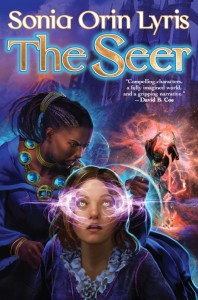Today we have a guest post by Sonia Orin Lyris, the author of The Seer. Be sure to check out her biography at the end of the post!

Dear reader: how do you like your story prepared? Roasted? Grilled? Lightly poached in white wine with thyme? Do you prefer farm-raised or wild-caught?
We writers with created worlds and involved back-stories have a special challenge to get the reader to consume our story, to relish the taste. How best to do this?
There are so many answers: sensory details, sympathetic characters, compelling dialog, riveting dramatic questions…
Oh, and cats that need saving!
So many ways to get the reader to take a bite and then another and to want more. These all tools work, depending on the story, genre, reader, and so on.
We’ve got a lot to say, we writers. Setting and feel, characters and descriptions — so much to tell! Do we put it all on the plate? Toss on garnishes? Maybe some chocolate sprinkles and a cherry?
Do we need dipping sauces?
It’s so easy to say too much. The finest of dishes are not heaps of every delectable that the chef can lay hands on. The best meals come to our table with focus. Nothing extra. Minimal, even.
For myself, as writer of a created world with a substantial back-story and involved plot, I use this guiding principle:
Honor the reader’s attention.
My job is to fill the reader’s metaphorical mouth with the finest of story flavors, but without being overwhelming. To seduce them into taking a marvelous journey with me, but with ever so light a touch. Delicately. Not by throwing I can everything onto the plate. Just the good stuff.
Certainly my own private notes about world-building, character, and plot are extensive. But in my final narrative, I keep the descriptions of landscape, clothing, food, and so on as minimal and focused as possible. They must be highly relevant, not only to the story, but to the current action from the viewpoint of the POV character.
That is, they must matter. That is, without them, the story would suffer.
Remember in that one book, how you skimmed part of the narrative because it wasn’t all that tasty? Entirely skippable? Like smooshed peas, or aunt Cora’s beet-and-anchovy salad, a narrative you just didn’t want to consume?
Let’s take it off the plate. Out of the story entirely. Because if the reader doesn’t need it, neither does the story.
And just how much can you take out? It’s a worthwhile exercise, and I’m always surprised how much description and back-story I can take out and still have a very fine story. A splendid meal, even!
When I’m doing rewrites and clean-up, I go back to my basic tenet: don’t waste the reader’s time. I focus my story on the most important aspects of the tastes I’m trying to convey.
Then — yes, sometimes with a deep sigh — I take out more.
For me, the story is all about the reader. In my perfect world, my reader falls into my story unimpeded by the words, my book very nearly vanishing in their hands, so that while they’re reading, all they are aware of is the world and characters that I’ve created for them.
And that the cat is happily curled up on a soft cushion by the fireplace, dreaming of chasing wild stories.
 Sonia Orin Lyris is the author of The Seer (http://bit.ly/seersaga), a high fantasy novel from Baen Books (http://www.baen.com/). Her published fiction includes fantasy, science fiction, horror, mainstream, and more, and may be found at lyris.org/fiction (http://lyris.org/fiction/). Follow her on Facebook (https://www.facebook.com/authorlyris/) or Twitter (https://twitter.com/slyris).
Sonia Orin Lyris is the author of The Seer (http://bit.ly/seersaga), a high fantasy novel from Baen Books (http://www.baen.com/). Her published fiction includes fantasy, science fiction, horror, mainstream, and more, and may be found at lyris.org/fiction (http://lyris.org/fiction/). Follow her on Facebook (https://www.facebook.com/authorlyris/) or Twitter (https://twitter.com/slyris).
Comments are closed.